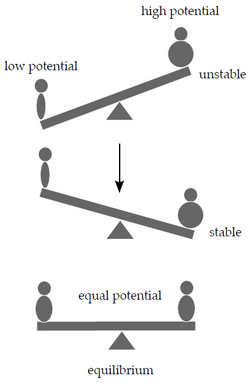Chemical Potential (FBLT)
Let's try to get closer to why chemical reactions take place as a response to changes in the system. A swing analogy will help. A heavy person will sooner or later outweigh a lighter one, while two people of the same weight will end up in a state of equilibrium at the same level above the ground after a while.
We can explain the phenomenon using the potential energy of both people in the Earth's gravitational field. Gravitational potential energy depends on the mass and position of the object in the gravitational field. The system we used in the swing example will try to minimize its potential energy by moving the heavier person as low to the ground as possible.
Similarly, chemical potential μcan be defined as the potential energy contained in a certain amount of substance that can be released during chemical reactions. Analogous to our example with the see-saw, on both sides of the chemical equation are substances with different potentials. If the sum of the chemical potentials of the reactants exceeds that of the products, the reaction will proceed from left to right, and vice versa. If the potentials are equal, the system has reached equilibrium.

